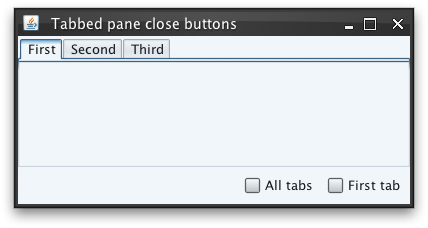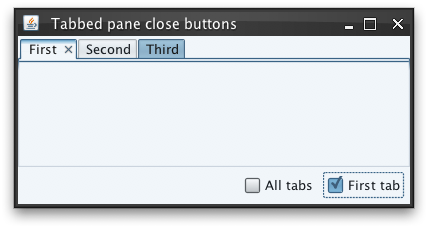|
import java.awt.BorderLayout;
import java.awt.FlowLayout;
import java.awt.event.ActionEvent;
import java.awt.event.ActionListener;
import javax.swing.JCheckBox;
import javax.swing.JComponent;
import javax.swing.JFrame;
import javax.swing.JPanel;
import javax.swing.JTabbedPane;
import javax.swing.SwingUtilities;
import org.pushingpixels.substance.api.SubstanceLookAndFeel;
import org.pushingpixels.substance.api.skin.BusinessBlackSteelSkin;
/**
* Test application that shows the use of the
* {@link SubstanceLookAndFeel#TABBED_PANE_CLOSE_BUTTONS_PROPERTY} client
* property.
*
* @author Kirill Grouchnikov
* @see SubstanceLookAndFeel#TABBED_PANE_CLOSE_BUTTONS_PROPERTY
*/
public class TabbedPaneCloseButtonsProperty extends JFrame {
/**
* Creates the main frame for <code>this</code> sample.
*/
public TabbedPaneCloseButtonsProperty() {
super("Tabbed pane close buttons");
this.setLayout(new BorderLayout());
// create a tabbed pane with few tabs
final JTabbedPane jtp = new JTabbedPane();
jtp.addTab("First", new JPanel());
jtp.addTab("Second", new JPanel());
jtp.addTab("Third", new JPanel());
this.add(jtp, BorderLayout.CENTER);
JPanel controls = new JPanel(new FlowLayout(FlowLayout.RIGHT));
final JCheckBox allHaveCloseButton = new JCheckBox("All tabs");
allHaveCloseButton.addActionListener(new ActionListener() {
public void actionPerformed(ActionEvent e) {
// based on the checkbox selection, mark the tabbed pane to have
// close buttons on all tabs
jtp
.putClientProperty(
SubstanceLookAndFeel.TABBED_PANE_CLOSE_BUTTONS_PROPERTY,
allHaveCloseButton.isSelected() ? Boolean.TRUE
: null);
jtp.revalidate();
jtp.repaint();
}
});
final JCheckBox firstHasCloseButton = new JCheckBox("First tab");
firstHasCloseButton.addActionListener(new ActionListener() {
public void actionPerformed(ActionEvent e) {
// based on the checkbox selection, mark the first tab component
// to have close button
((JComponent) jtp.getComponentAt(0))
.putClientProperty(
SubstanceLookAndFeel.TABBED_PANE_CLOSE_BUTTONS_PROPERTY,
firstHasCloseButton.isSelected() ? Boolean.TRUE
: null);
jtp.revalidate();
jtp.repaint();
}
});
controls.add(allHaveCloseButton);
controls.add(firstHasCloseButton);
this.add(controls, BorderLayout.SOUTH);
this.setSize(400, 200);
this.setLocationRelativeTo(null);
this.setDefaultCloseOperation(JFrame.EXIT_ON_CLOSE);
}
/**
* The main method for <code>this</code> sample. The arguments are ignored.
*
* @param args
* Ignored.
*/
public static void main(String[] args) {
JFrame.setDefaultLookAndFeelDecorated(true);
SwingUtilities.invokeLater(new Runnable() {
public void run() {
SubstanceLookAndFeel.setSkin(new BusinessBlackSteelSkin());
new TabbedPaneCloseButtonsProperty().setVisible(true);
}
});
}
}
The screenshot below shows tabbed pane with no close buttons
(this property is not set):

The screenshot below shows tabbed pane with close button only on the first tab
- this property is set to Boolean.TRUE. Note
that the mouse is over the third tab which doesn't show the close button:

The screenshot below shows tabbed pane with close buttons on the tabbed pane (all tabs)
- this property is set to Boolean.TRUE. Note
that the mouse is over the third tab which shows the close button:

|
![]() View all API methods.
View all API methods.
![]() View all client properties.
View all client properties.


